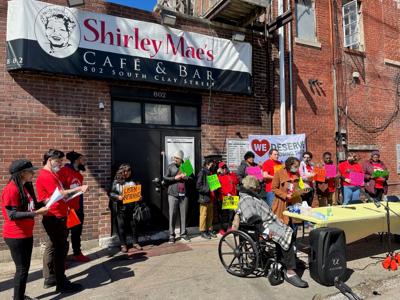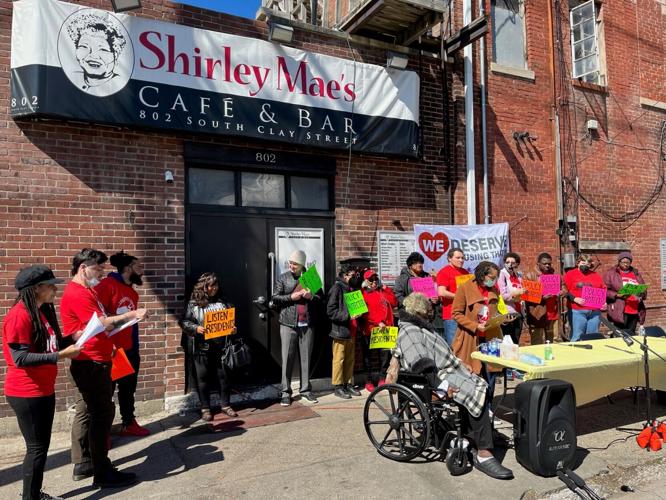LOUISVILLE, Ky. (WDRB) – Legislation to be filed at Metro Council seeks to protect residents in eight predominantly Black areas in Louisville against possible displacement from future development.
The Historically Black Neighborhoods Ordinance would designate the current and former neighborhoods and communities of Berrytown; California; Limerick; Little Africa; Petersburg; Russell; Shawnee; and Smoketown. Among other things, it would require any commercial or residential development proposal within those boundaries that seeks to use city resources -- such as financial incentives or publicly-owned land – to have an assessment done to determine if residents might be displaced.
Any development that fails the assessment wouldn't qualify to use public aid like incentives or land, according to a draft of the ordinance.
“At its heart, it prevents Louisville Metro government from giving away public resources such as money, land and staff support to development projects that would increase the cost of living in historically Black neighborhoods,” said Jessica Bellamy, an organizer with the Louisville Tenants Union. “This component of the ordinance will force Metro government to prioritize the use of those resources on development projects that are genuinely designed to support and house our community.”
Bellamy was among a group backing the legislation that rallied in Smoketown Wednesday, saying residents need the protections to combat rising rents and gentrification pressure. She said she grew up in Smoketown but hasn’t been able to return as an adult because of skyrocketing rents and property taxes.
A 2019 city-funded housing report concluded that there is a “growing challenge to help guard against the displacement of current residents and businesses” due to rising home values in older, lower-income areas near the city’s urban core.
That report also found that the risk of displacement is highest in neighborhoods such as Russell, where the former Beecher Terrace public housing complex is being replaced with new apartments; and in Smoketown, home to “more frequent and profitable” renovations of older homes.
Bellamy said residents of the eight neighborhoods have worked for two years to craft the ordinance, which also would give residents priority in downpayment assistance, home repair and other city programs. She said a petition supporting the measure has signatures from people living in 25 of the Metro Council’s 26 districts.
The ordinance would create “a pathway to restoring land that was wrongfully taken from families by the government,” Bellamy said. “This land would have been inherited by our children, our children's children, and that land needs to be returned -- if not something comparable given should the case be made that that land was taken wrongfully.”
A citizen would have to request an investigation, which would be conducted by a newly created, resident-led board along with city agencies, she said.
Robert Boone, who said he lives in Park Duvalle but grew up in the old Clarksdale Homes, said he and his wife wanted to move to Smoketown after leaving the Liberty Green mixed-income community that replaced Clarksdale.
“We don't deserve to be priced out of our place where we call home,” he said. “We need Metro Council to pass the Historically Black Neighborhoods Ordinance so we can protect our right to remain in our communities and to start to carve a path of restoring them.”
Metro Council member Jecorey Arthur (D-4th District) cited the 2019 housing report in his remarks to a crowd outside Shirley Mae’s Café & Bar on S. Clay Street, noting that it lists anti-displacement measures as a possible policy strategy.
“All these years later, and we're finally doing something about it,” Arthur said. “Because the power of the people is stronger than the people in power.”
He told WDRB News that the ordinance could be filed by the council’s next deadline for new business on April 10. “We want to get it right,” Arthur said.
A new entity – the 19-member Historically Black Neighborhoods Commission – would be created through the ordinance and put in charge of conducting the displacement assessments and other work, he said.
Those members would include 16 from the eight neighborhoods/areas, one from the city’s Office of Housing and Community Development, one from the Louisville Forward economic development agency and one from the city’s Human Relations Commission.
Arthur said the outsized membership from the neighborhoods is in contrast to the West End Opportunity Partnership, the board created by the Kentucky legislature to manage tax revenues from a massive tax increment financing, or TIF, district in the city’s West End.
The partnership board is made up of 21 members, including nine neighborhood representatives and nine from organizations, along with appointees from Kentucky’s governor, Louisville’s mayor and the Metro Council.
Louisville Metro government contributed $10 million to the TIF board, which will use $30 million in public and private donations and a share of new tax revenue created in the area to fund yet-to-be-determined projects.
Supporters say the additional revenue will boost economic development in part of the city in need of new investment. Critics of the TIF plan argue that one outcome could be the displacement of longtime residents.
Bellamy, a longtime critic of the TIF plan, said if the Historically Black Neighborhood Ordinance had been in place when those Metro funds were committed, “it would have been a lot harder for the city to put money towards anything that could displace.”
Copyright 2023 WDRB News. All rights reserved.














